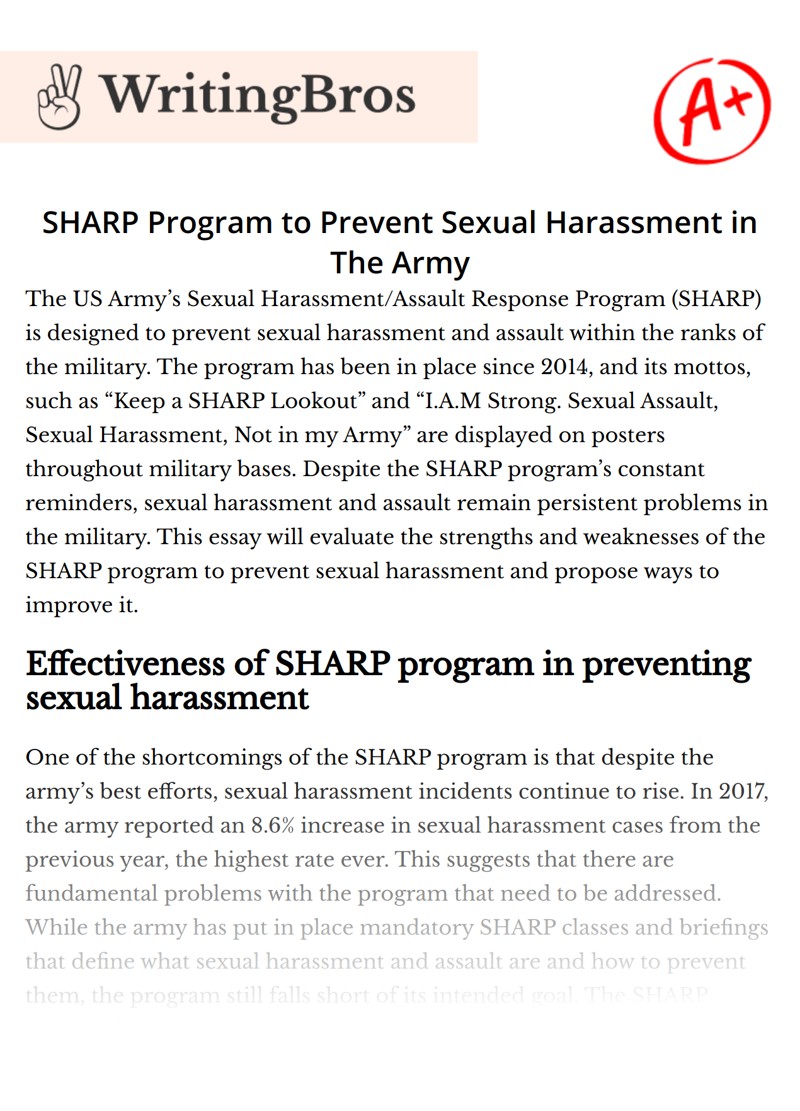SHARP Program to Prevent Sexual Harassment in The Army

The US Army’s Sexual Harassment/Assault Response Program (SHARP) is designed to prevent sexual harassment and assault within the ranks of the military. The program has been in place since 2014, and its mottos, such as “Keep a SHARP Lookout” and “I.A.M Strong. Sexual Assault, Sexual Harassment, Not in my Army” are displayed on posters throughout military bases. Despite the SHARP program’s constant reminders, sexual harassment and assault remain persistent problems in the military. This essay will evaluate the strengths and weaknesses of the SHARP program to prevent sexual harassment and propose ways to improve it.
Effectiveness of SHARP program in preventing sexual harassment
One of the shortcomings of the SHARP program is that despite the army’s best efforts, sexual harassment incidents continue to rise. In 2017, the army reported an 8.6% increase in sexual harassment cases from the previous year, the highest rate ever. This suggests that there are fundamental problems with the program that need to be addressed. While the army has put in place mandatory SHARP classes and briefings that define what sexual harassment and assault are and how to prevent them, the program still falls short of its intended goal.
The SHARP program’s mandatory classes may not be effective in addressing the root causes of sexual harassment and assault. AC Davis, an army veteran, observed a mandatory SHARP classroom training and noted that the hour-long presentation failed to adequately address the systemic problems that underlie sexual harassment and assault in the military. The program relies on a one-size-fits-all approach that does not account for individual experiences or provide effective solutions.
On the other hand, the SHARP program does a good job of providing soldiers with information about what constitutes sexual harassment and assault, as well as policies and penalties associated with these behaviors. The class includes scenarios and diagrams to distinguish between harassment and assault, and keeps soldiers engaged through interactive activities. The program encourages soldiers to take responsibility for their actions and understand the impact of their behavior on others.
To improve the effectiveness of the SHARP program, the army needs to address the underlying issues that contribute to sexual harassment and assault in the military. This requires a deeper understanding of the causes and drivers of these behaviors. Soldiers should be encouraged to share their experiences and ideas, and the program should provide resources and support to those who have experienced sexual harassment or assault.
Another way to improve the program is to tailor it to the specific needs of different groups within the military. For example, the experiences of female soldiers may differ from those of male soldiers, and different branches of the military may have unique challenges. By taking these factors into account, the program can provide more targeted solutions that are more effective in preventing sexual harassment and assault.
In conclusion, the SHARP program has been in place since 2014 with the aim of reducing sexual harassment and assault in the US Army. While the program provides valuable information about what constitutes these behaviors and their consequences, it falls short in addressing the root causes of the problem. To improve the effectiveness of the program, the army needs to take a more individualized approach, provide resources and support to those who have experienced sexual harassment or assault, and tailor the program to the specific needs of different groups within the military. With these improvements, the army can move closer to achieving its goal of eradicating sexual harassment and assault within its ranks.
References
- Department of Defense. (2018). Annual report on sexual assault in the military. Retrieved from https://www.sapr.mil/sites/default/files/DoD_SAPRO_Annual_Report_FY2018_Executive_Summary_0.pdf
- Hebert, K. (2018). The role of leadership in preventing military sexual assault. Military Review, 98(2), 11-18. Retrieved from https://www.armyupress.army.mil/Journals/Military-Review/English-Edition-Archives/May-June-2018/The-Role-of-Leadership-in-Preventing-Military-Sexual-Assault/
- Kuehn, J. (2017). Rethinking military sexual assault prevention. Joint Force Quarterly, 85, 121-127. Retrieved from https://ndupress.ndu.edu/Media/News/News-Article-View/Article/1256997/rethinking-military-sexual-assault-prevention/
- McPherson, M. J., & Zych, J. A. (2017). Sexual assault prevention in the military: A systematic review of risk and protective factors. Trauma, Violence, & Abuse, 18(3), 252-267. doi: 10.1177/1524838016649492
- O’Brien, R., Keith, L. M., Shoemaker, L., & Penn, N. (2016). Prevention and response to sexual assault and harassment in the military: Implementing the Department of Defense’s comprehensive strategy. American Psychologist, 71(8), 742-751. doi: 10.1037/a0040346
Cite this Essay
To export a reference to this article please select a referencing style below

